Content
- 1 Home and garden care
- 2 Reproduction
- 3 Signs of trouble
- 4 Diseases and pests
- 5 Beneficial features
- 6 General information about the plant laurel tree
- 7 Bay leaf - we grow at home
- 8 Laurel - houseplant
- 9 Growing laurel from seeds
- 10 How to propagate bay leaves at home
- 11 Recommendations for proper cultivation

Laurel is a relict plant that formed in the Tertiary period - and it seems to be much older than humanity.
The legends surrounding this tree-bush, to match its antiquity: it is also a material for crowning winners and other prominent personalities (hence the word "laureate"), this is "Fuse" from the wrath of Zeus - a lightning strike, and the eternal companion of the patron saint of all arts Apollo.
Ancient beliefs are woven into these legends not by chance, because laurel in nature is widespread just in the territories of the great civilizations of antiquity - in the Mediterranean. It also grows in the Krasnodar Territory.
At the same time, laurel - unpretentious plant, uncomplicated room culture, as well as when kept in a garden plot - in those areas where the average winter temperature fluctuates around zero.
…
How to grow a laurel tree, plant propagation, caring for laurel at home, diseases and photos - read all this and more in our article.
Home and garden care
When caring for a laurel tree at home and in the open field, some points must be observed. Let's consider them in more detail.
Lighting
Laurel is a quite hardy plant; it will be able to grow in moderate light, but best of all it will develop - and, moreover, actively branch - in bright, mainly diffused, light. It should be protected from the excess of scorching sunlight.
Temperature
 Before growing laurel at home, you need to know that the best summer temperature range is from 18 to 20 degrees, and winter - from 10 to 15 degrees.
Before growing laurel at home, you need to know that the best summer temperature range is from 18 to 20 degrees, and winter - from 10 to 15 degrees.
The laurel is most pleasant to live in the fresh air - on the balcony, in the courtyard or in the country, including throughout the year - if winter temperatures are kept at + 5-6.
ATTENTION: zero temperatures for him are already a risk zone, and a decrease in temperature to -10-12 ° С laurel can only withstand a short time.
Priming
To grow laurel at home and in the open field, you need to prepare a soil mixture - this is ordinary garden soil, universal soil from a store or a loose nutrient mixture with a neutral reaction, self-prepared according to one of the following recipes:
- one part of leaf, the same amount of sod land and humus with the addition of two parts of river sand;
- two parts of sod land and one each of leafy land, humus, peat and sand with the addition of wood ash in a small amount.
Watering
The plant should be watered abundantly in the spring and summer.
IMPORTANT! At the same time, moisture stagnation in the soil should not be allowed: the water flowing down after irrigation into the pan should be immediately drained.
Irrigation water is taken soft, not cold - well-settled water supply or rainwater.
With a cool winter, which will bring great benefits to the laurel, watering is needed moderately - about once a week or less often, in order to prevent the soil from drying out. If the wintering is warm, water it more often and be sure to regularly humidify the air.
Air humidity
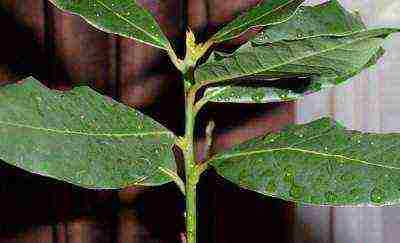 IMPORTANT: air humidity in winter should be sufficient, and in summer - high. This is a prerequisite for the successful cultivation of laurel.
IMPORTANT: air humidity in winter should be sufficient, and in summer - high. This is a prerequisite for the successful cultivation of laurel.
When caring for indoor laurel, you should carry out regular spraying with soft water. You can also put the plant in a tray with damp pebbles, place wide vessels with water nearby.
ATTENTION: however, the air must be sufficiently fresh. At home, the bay tree should be in a well-ventilated area.
Top dressing
In the spring-summer period of active vegetation twice a week the plant is supported with complex fertilizers, alternating with mineral and organic compounds.
In autumn and winter, the frequency of fertilizing is reduced to monthly or even more rare. It depends on the thermal regime in which the laurel is contained: during a cool winter, fertilization will be needed much less often.
Growth and flowering
In indoor culture, the plant lives for about 15 years, on the site, in the same place - up to 60 years. Bush able to grow up to 10-15 meters in height. Laurel at home is limited to 1.5-2 meters by pruning.
Small yellowish flowers bloom in early spring, in March-April, and on some plants - only staminate, on others - only pistillate. When growing flowering in the room is a rarity. After pollination, the fruits ripen - blue berries.
Pruning
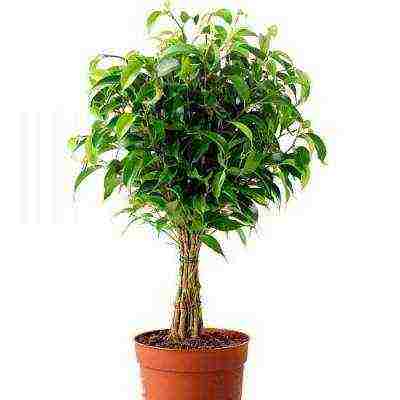 When caring for a laurel tree at home - a bush responds well to pruning, forming a lush crown: spherical, cubic, pyramidal.
When caring for a laurel tree at home - a bush responds well to pruning, forming a lush crown: spherical, cubic, pyramidal.
Laurel pruning is carried out from the age of 5.
There are two deadlines for this operation: end of summer (August), immediately after the end of the active growing season and late autumn (October-November), in the transition to a state of rest.
In an open area, damaged branches are cut off in early spring.
Landing
How to grow laurel at home? Answering this question, it is important to remember that when planting laurel at home, a container with a mandatory drainage hole should have standard dimensions and an optimal ratio with the growth of the seedling: the vertical size of the pot is from a quarter to a third of the plant's height.
Before planting the laurel, a drainage layer (expanded clay, small pebbles, brick fight) is placed at the bottom of the container.
Then a small amount of prepared soil is poured, on top of it - root system with saved, if possible, earthen lump. Pour the soil mixture to the desired level, carefully tamping it.
Transfer
Young, first five years of life, plants are transplanted, as a rule, every year, adults - once every 2-3 years, and then even less often.
ATTENTION! The method of transplanting should be transshipment, in which the earthen lump is preserved as much as possible, and the new pot is not much larger, by 2-4 centimeters, larger than the old one in diameter.
To your attention the indoor laurel and its photo:





You can also watch a video on how to care for laurel at home:
Reproduction
Reproduction of laurel is possible by seeds, as well as vegetatively - by cuttings and layering.
Seeds at home
ATTENTION! When growing laurel from seed, there are two main difficulties: laurel seeds quickly enough, in 3-5 months, lose a significant percentage of germination and, due to the high content of oils, germinate very slowly, up to six months.
Therefore, the seed should be as fresh as possible, and to see the germinated seeds, you should be patient. Laurel is sown in January-February. To accelerate germination seeds are treated with a solution of a growth stimulant, and then planted to a depth of 1-1.5 cm in a moist, light soil.
Cover with plastic wrap, keep at 18 degrees, regularly ventilate and maintain the moisture content of the substrate.
IMPORTANT! Monitor seeds for possible mold by monitoring their condition on a weekly basis. If a white bloom appears, remove it and wash the seeds in a weak solution of potassium permanganate.
As soon as germination begins, the seed coat cracks and then they can be immediately transplanted into separate containers, by placing in the ground at a depth of five centimeters, - but you will need to wait about a month for seedlings.
IMPORTANT: young "bay leaves" should be protected from heat and excess sunlight.
In the open field
Ripening of laurel fruits occurs in October-November. Once harvested, the seeds are released and scattered over a permanent area, at a depth of about 5 cm. Shoots, usually appear from late spring to late summer, at a temperature of + 20-22 ° C.
When planting laurel with seeds, the seedlings are thinned out to a distance of 5-8 cm between individual plants. Sometimes there are shoots in January, which, for the most part, die.
Propagation by cuttings
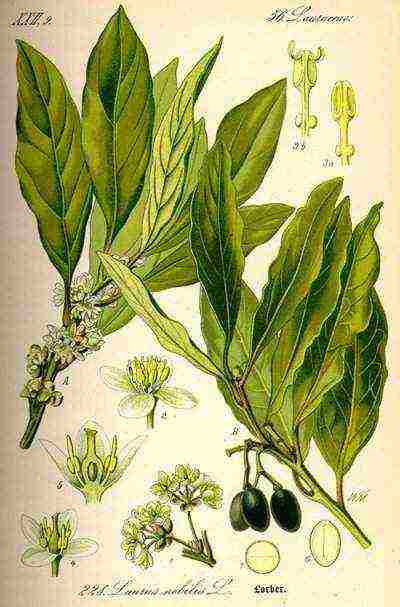 The best time for harvesting and rooting of laurel cuttings in a room culture is March – April or June – July;
The best time for harvesting and rooting of laurel cuttings in a room culture is March – April or June – July;
ATTENTION: in an open area, cuttings are carried out only in June-July.
Cuttings with three internodes (usually 6-8 cm long) are cut from the middle and lower parts of semi-lignified shoots.
The bottom sheet is removed, the rest are shortened by half and send the prepared cuttings for rooting.
At 16-20 degrees, they are buried 1-1.5 cm into the moistened sand. Cover with plastic wrap ventilate, spray.
Rooted cuttings begin to grow, as a rule, after a month, and when they grow by 2-3 cm, they are seated in separate containers.
To your attention a video about laurel propagation by cuttings at home:
Reproduction by layering
Usually, laurel gives lateral processes with a more or less developed root system, which are carefully separated and planted. Sprinkle the injured areas with crushed charcoal.
Thus, when growing laurel you can focus on the following calendars of main jobs:
In the open field
Spring
March-April - sanitary pruning: removal of damaged and frost-bitten branches. Rooting cuttings in a cold greenhouse.
Top dressing
Summer
The whole period is the germination of seeds sown in the fall. Regular feeding
June-July - propagation by cuttings
August - formative pruning
Autumn
October-November: pruning, harvesting deciduous raw materials, harvesting fruits, sowing seeds
At home
Spring
March - sowing seeds.
March-April - propagation by cuttings, separation of lateral processes.
Top dressing
Summer
The entire period is the germination of seeds sown in February-April. Regular feeding.
June-July - propagation by cuttings
August - formative pruning
Autumn
October-November: pruning, harvesting of deciduous raw materials. Rare feeding.
Winter
February - sowing seeds
Signs of trouble
Leaves turn yellow, curl and fall off - insufficient air humidity. Regular spraying should be established.
The outer side of the leaves is covered with brown spots. - waterlogging of the soil, especially in combination with low air temperature and / or irrigation water. Watering needs to be optimized.
Why do the leaves turn black?
The leaves are covered with a spotted black bloom, which is easily erased from the surface of the leaf blade - a sooty fungus that settles where it is traces of vital activity of insect pests: scale insects or mealybugs. First of all, they get rid of pests, then remove plaque. In case of severe damage, the affected leaves are removed.
Diseases and pests
A healthy, well-groomed plant is practically not susceptible to diseases and pests. With improper home care on the laurel spider mites, scale insects, mealybugs may appear. This is especially likely with insufficient air humidity.
As a first measure, the affected areas are treated with soapy water, and the most reliable means of controlling insect pests are directional insecticides.
Beneficial features
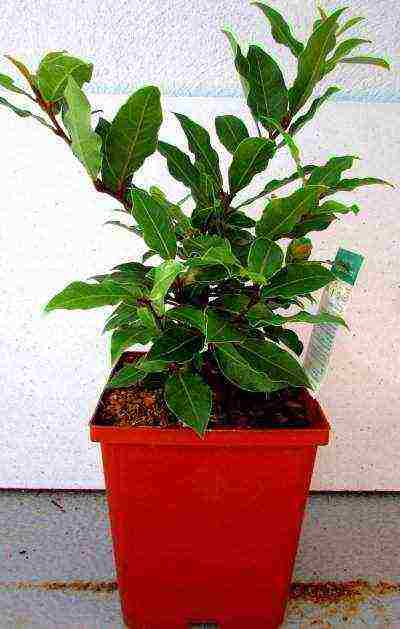 The aroma and pleasant bitterness inherent in laurel have made its leaves an extremely popular spice that induces appetite and aids digestion.
The aroma and pleasant bitterness inherent in laurel have made its leaves an extremely popular spice that induces appetite and aids digestion.
Essential laurel oil has disinfectant and insecticidal properties.
As a prophylaxis against painful processes in the intestines, inflammation of the upper respiratory tract, it is enough just to grow laurel in the room and inhale its aroma.
To enhance the smell of the plant can be sprinkled with aspirin solution twice a week (5 g per liter of water) or glucose (1 ml per 1 liter of water). Healing decoctions and infusions of bay leaves are also prepared.
Application
Fatty oil is extracted from the fruit, which is used in medical practice to make balls and candles. Moreover, it is a good antiseptic, and is also used in massage procedures. Laurel fruits are also used as a spice.
You learned how the laurel tree differs, caring for it in the open field and at home, how to grow laurel from seeds, and that having your own personal bush-tree, completely covered with ready-made laurel leaves, you can forever say goodbye to colds, inhaling all year round air saturated with phytoncides tree of winners.
The laurel tree is used in interior design, gardening of street beds and creating decorative compositions. Laurel differs in leaf shape and size, suitable for growing both indoors and outdoors.
Laurel is used in pharmacology, leaves and fruits are used, from which extracts, infusions and oils are subsequently made. The plant is widely used as a diuretic, relieves flatulence, intestinal colic, laurel ethers are removed from depressive conditions. Laurel leaves are used as a condiment.
The content of the article:
- Description of the plant
- Types of laurel
- How to grow a bay tree in a pot
- How to care for a laurel tree
- Diseases and pests of the laurel tree
Description of the plant
The laurel tree comes from a genus of evergreen plants of the laurel family. For a long time, laurel trees have been cultivated in many subtropical countries.
Laurel includes three types: camphor, noble and Azores.
The tree contains 3.5 to 5.5% essential oils. The tree is dioecious, with a dense crown, has a pyramidal shape and evergreen foliage, hard and smooth. In nature, it reaches a height of about 25 meters.
 Flowering begins in spring, the tree is covered with umbellate, unisexual, axillary inflorescences of a milky or pale yellow color. The fruits are single-seeded, fragrant drupes of blue and black shades, ripening in autumn.
Flowering begins in spring, the tree is covered with umbellate, unisexual, axillary inflorescences of a milky or pale yellow color. The fruits are single-seeded, fragrant drupes of blue and black shades, ripening in autumn.
The life span of the laurel is amazing, the tree can exist for about three hundred years. An ennobled tree will quickly run wild without proper care. Bay leaves are considered one of the irreplaceable seasonings in pickles and marinades.
Laurel is often found in Georgia, Greece, Crimea, Asia, the Black Sea coast and Transcaucasia.
Types of laurel
There are three types of laurel tree:
Camphor, Whose homeland is China. The plant is quite popular in Asia and India. It is an evergreen plant with tough, lanceolate, fleshy, speckled leaves.
Flowering lasts about one and a half weeks, with yellowish inflorescences.
The laurel tree contains a lot of camphor oil, most of it is in the trunk and wood of laurel about 90%. The production of camphor is widespread in Japan and China, where oil is obtained from laurel shavings and branches by distillation.
 In addition to camphor oil, laurel leaves contain a large amount of selenium and tannins. Camphor oil is considered one of the best medicinal substances in the fight against heart disease, depression, for the prevention of infectious diseases.
In addition to camphor oil, laurel leaves contain a large amount of selenium and tannins. Camphor oil is considered one of the best medicinal substances in the fight against heart disease, depression, for the prevention of infectious diseases.
Outwardly, camphor oil is used for rubbing sore joints and bruises, as an analgesic, distracting and anti-inflammatory agent.
Noble laurel. The most common type of laurel tree, it grows in the southern part of the country and in the Mediterranean. Laurel trees reach up to 5 meters in height. The branches are glabrous and fleshy.
The foliage is lanceolate, on a short petiole, with a glossy surface, oblong in shape. Laurel bloom occurs in spring and lasts about a week. Inflorescences with small flowers, collected in yellow umbrellas.
 The noble laurel is used to compose decorative compositions and decorate interiors. The noble species is unpretentious and resistant to drought, grows well in pots in indoor conditions. The foliage is used as an essential oil and as a spice.
The noble laurel is used to compose decorative compositions and decorate interiors. The noble species is unpretentious and resistant to drought, grows well in pots in indoor conditions. The foliage is used as an essential oil and as a spice.
The winners in Ancient Greece were awarded with a branch of noble laurel, the plant was attributed to divine origin.
Azores laurel or Canary laurel tree. The Azores islands are considered the birthplace of the plant. The trees grow up to 12 meters in height with large leaves, dark green in color, 5.5 cm wide.
Blooms in spring. Pale yellow inflorescences are collected in umbrellas and are located in the axils of the foliage. Azores laurel is often used for decoration.
The most common varieties of laurel trees are narrow-leaved and willow laurel.
 How to grow a bay tree in a pot
How to grow a bay tree in a pot
For home cultivation, the noble type of laurel tree is best suited. Timely care, pruning, watering and feeding are integral parts of a healthy plant.
It is best to grow the laurel tree from mature seed, southern species. A favorable time for planting laurel seeds is the end of winter - the beginning of spring, the seeds should be planted in a specially prepared substrate.
To do this, mix black soil with sand and peat in a ratio of 3: 1: 1, fill a pot with it and plant a seedling to a depth of 1.5-2 cm.
Before planting, the soil must be disinfected; for this, warm it up to 120 degrees in the oven.
For intensive growth, the tree will need a temperature of at least +22 degrees. The first “fruits” of laurel seed planting will be visible after 3.5 months.
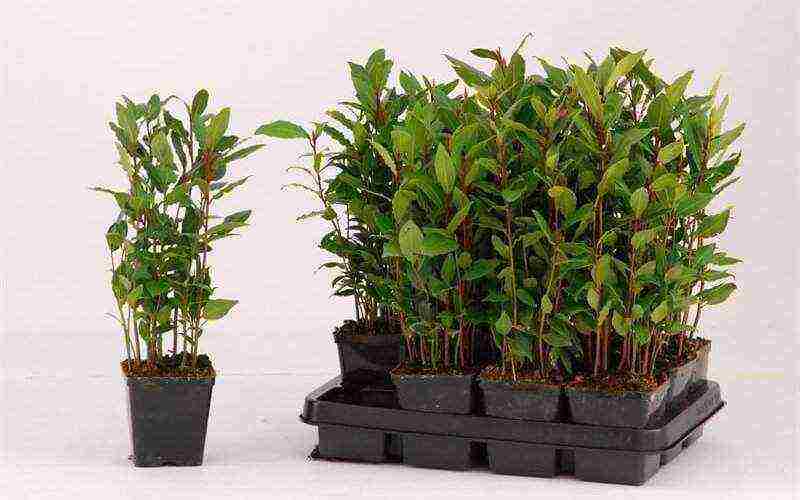 Lavrushka seeds do not require special preparation, but it will not be superfluous to keep them in a strong solution of potassium permanganate for a day to protect and increase the rate of sprout appearance. Excessive watering is not required, it will be enough to water the seedling 3 times a week.
Lavrushka seeds do not require special preparation, but it will not be superfluous to keep them in a strong solution of potassium permanganate for a day to protect and increase the rate of sprout appearance. Excessive watering is not required, it will be enough to water the seedling 3 times a week.
The seed pot must be installed on a sunny windowsill and covered with a glass lid for better heating of the soil, but do not forget to arrange ventilation and make sure that the fungus does not start in the soil with high moisture content.
As soon as the first green sprout appears, the glass is removed and the soil in the pot is not allowed to dry out, but also moisture stagnation is prevented. It is worth taking care of this in advance by laying out the bottom of the pot with expanded clay or river pebbles and making drainage holes in the container.
 The tree requires special attention in the first year of its existence, since during this period the young plant is too vulnerable and capricious. A well-lit place, warmth, lack of draft and sufficient moisture are the first on the way to healthy growth of evergreen laurel.
The tree requires special attention in the first year of its existence, since during this period the young plant is too vulnerable and capricious. A well-lit place, warmth, lack of draft and sufficient moisture are the first on the way to healthy growth of evergreen laurel.
Avoid prolonged direct exposure to sunlight on the young tree, otherwise the foliage may fall off or dry out. Better when the light is diffused or with variable solar activity. A shaded window sill will prevent the laurel from expanding in breadth, the tree will begin to ache and stretch upward, sometimes giving out ugly, long, bizarre forms of weed vegetation.
In summer, the laurel tree can be left outside, in places with a changeable sun, the temperature of the tree's special comfort ranges from +16 to +22 degrees. Laurel will respond to daily spraying with a thick, dark crown, glossy shine of the leaves and will acquire a wide trunk.
 In the autumn months, the plant enters a dormant phase, but just at this time the heating season begins, so the conditions for sleeping lavrushka must be recreated on their own, artificially. Either place the plant on the south side of the insulated balcony, where the temperature would not drop below -3 degrees, or put it in a lighted room, but with a temperature not higher than +13 and maintain this temperature from November to the end of February.
In the autumn months, the plant enters a dormant phase, but just at this time the heating season begins, so the conditions for sleeping lavrushka must be recreated on their own, artificially. Either place the plant on the south side of the insulated balcony, where the temperature would not drop below -3 degrees, or put it in a lighted room, but with a temperature not higher than +13 and maintain this temperature from November to the end of February.
How to care for a laurel tree
Laurel, like other plants, needs care, and a young tree requires twice as much attention. The bay tree does not like dry air and hot rooms, from this the plant can turn yellow or shed its foliage.
Laurel needs a lot of light for normal development and rapid growth; direct sunlight with variable activity should become a reliable companion of a young plant.
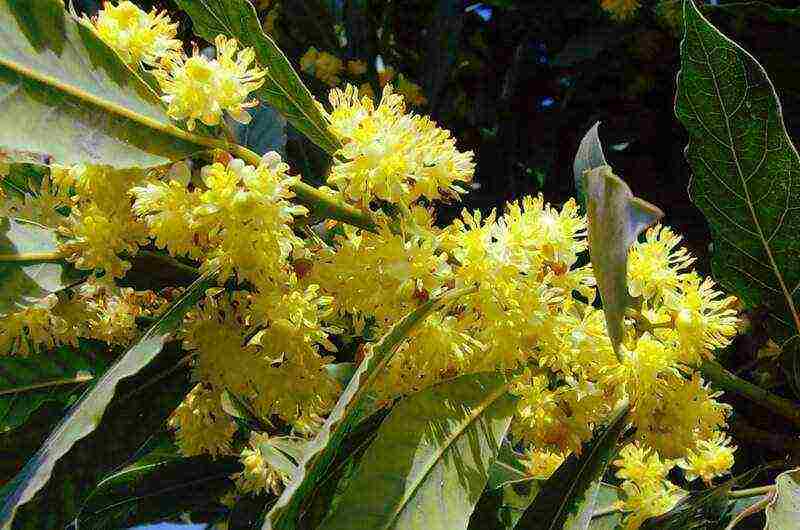 In the summer, the plant must be taken out into the air, but accustoming to direct sunlight should be smooth to avoid possible sunburn. In winter, the laurel tree is kept in a room with diffused light at a low temperature.
In the summer, the plant must be taken out into the air, but accustoming to direct sunlight should be smooth to avoid possible sunburn. In winter, the laurel tree is kept in a room with diffused light at a low temperature.
The optimal temperature conditions for a laurel tree are indicators from +22 to +27 degrees. But during wintering, the tree should be at a temperature not higher than +12 degrees.
Watering should be carried out at least 3 times a week, and more often in hot weather. In winter, watering is limited and reduced to once a week.
Like any plant, the laurel tree prefers high humidity, so spraying is necessary. An alternative can be a container filled with wet expanded clay, on which a pot with a plant is placed.
Top dressing is carried out every 3 months with mineral fertilizers.
Laurel tree pruning is performed with the aim of transforming the bush, for decorative purposes. The plant safely tolerates pruning.
A laurel tree can be given any shape, but frequent pruning can harm the plant, so the tree should be radically trimmed once, and then only maintain the given shape. Frequent pruning can damage laurel.
The bay tree grows slowly, but as the pot fills with roots, it needs replanting. The need for a transplant occurs every two years. The tree prefers a non-acidic soil with a neutral PH level.
Laurel is watered to soften the soil and taken out of the pot along with the soil, expanded clay drainage is poured into a new larger pot, a substrate from turf soil mixed with sand and peat, then a tree is placed and sprinkled with soil on top.
 The bay tree propagates by cuttings, seeds, and division.
The bay tree propagates by cuttings, seeds, and division.
Cuttings are harvested in the summer, the branches should be mature, flexible, with several internodes, 7-9 cm long.
Prepared cuttings are planted in sod soil to a depth of about 1 cm, and sand is poured on top of 1.5 cm and constantly moistened.
The standard temperature for better germination of the cuttings is + 17-21 degrees. The planted cuttings will take root in a month or a month and a half, after which they can be transplanted into ordinary pots to a permanent place of growth.
Transplanted cuttings should be sprayed like mature trees so that they quickly lay down and foliage. Top dressing of cuttings is necessary, they grow slowly, therefore, in order to avoid depletion, you should change the top layer of the soil to fertile black soil or use mineral dressing.
Diseases and pests of the laurel tree
Laurel is not very susceptible to disease, but there are some harmful insects that can lead to the death of the plant.
For example: Shield, the insect settles on the surface of the leaf and gradually sucks out the juice. From the outside, it looks like a yellow or white spot that constantly increases in size until it covers the entire leaf, which dries up and curls. The scabbards differ in the color of the shell (shield), due to which the pest got its name. Insects are white and light yellow, they multiply quickly and spread over neighboring plants. Therefore, it is very important to isolate the infected plant from healthy vegetation.
Shield, the insect settles on the surface of the leaf and gradually sucks out the juice. From the outside, it looks like a yellow or white spot that constantly increases in size until it covers the entire leaf, which dries up and curls. The scabbards differ in the color of the shell (shield), due to which the pest got its name. Insects are white and light yellow, they multiply quickly and spread over neighboring plants. Therefore, it is very important to isolate the infected plant from healthy vegetation.
The scale insect does not die from insecticide treatment, the insect protects the shell. They can only be removed manually, getting rid of them with an Ankara-treated bandage or infusion of garlic with vodka.
Treatment should be carried out on all affected areas of the plant, with the replacement of the top layer of the soil in order to get rid of the possible presence of larvae in it.
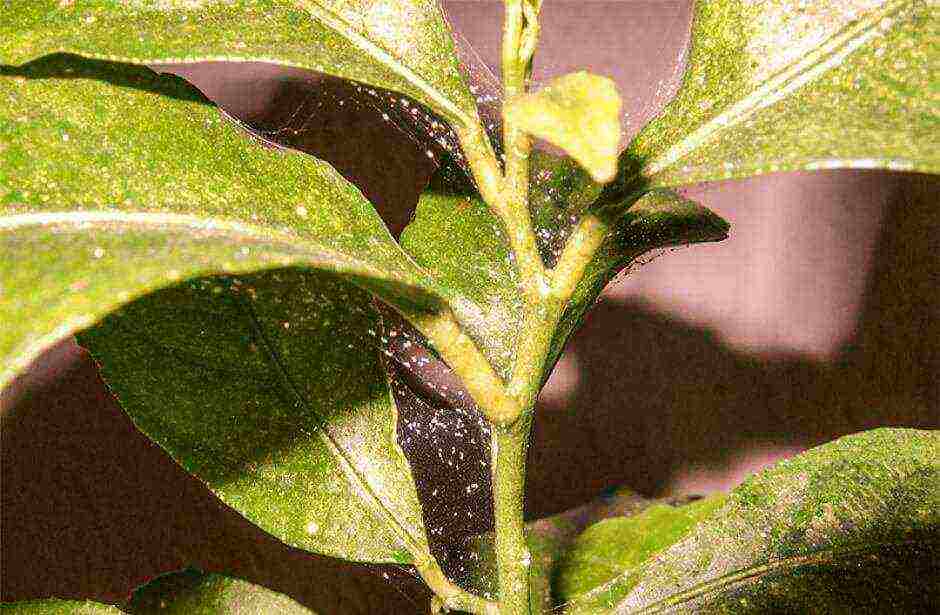 Another equally dangerous pest is the spider mite. A small insect that is very difficult to see with the naked eye, but a spider web in a pot and a white bloom on the plant should alert you.
Another equally dangerous pest is the spider mite. A small insect that is very difficult to see with the naked eye, but a spider web in a pot and a white bloom on the plant should alert you.
Spraying the soil with a weak solution of manganese will serve as prophylaxis. In a neglected state, the laurel tree is sprayed with insecticides or wiped the foliage with soapy water, followed by rinsing.
Sooty fungus fungal disease accompanied by a bloom of a black tint. Does not lead to the death of the plant, however, it noticeably spoils the appearance of the tree itself, affecting the foliage with black and large spots.
 Fungicidal preparations for domestic plants, as well as treatment with Bordeaux liquid, can defeat the fungus.
Fungicidal preparations for domestic plants, as well as treatment with Bordeaux liquid, can defeat the fungus.
In addition to pests, the laurel tree can shed leaves or turn yellow, in order to prevent an undesirable phenomenon, the tree must be sprayed, carried out weekly bathing. Protect from prolonged exposure to the sun, apply fertilizers, do not exceed the temperature regime, avoid stagnation of water in the pot.
If you follow all of the above measures, a healthy plant will delight the eye for a long time.
 The noble laurel is a tree that has become a cult tree, which is primarily associated with ancient Greece, as well as with the mythology and image of the god Apollo, which is a symbol of male beauty.
The noble laurel is a tree that has become a cult tree, which is primarily associated with ancient Greece, as well as with the mythology and image of the god Apollo, which is a symbol of male beauty.
For example, Ovid in "Metamorphoses" tells that once Apollo fell madly in love with the beautiful Daphne, a forest nymph, and pursued her day and night.
Once, when he defeated the serpent Python, Apollo met Eros - the young god of love and decided to play a trick on him. Apollo's taunt had an effect, and he sent 2 arrows at Apollo. Both arrows hit their targets - Daphne and Apollo.
Since that time, Daphne has always fled from Apollo. Nothing could help him win the heart of an unapproachable beauty. In anguish, Daphne decided to turn to Earth and Peney to take her image.
After her request was fulfilled, she was turned into a laurel bush. Since then, Apollo, saddened for all his life, wore a wreath of laurel bush leaves on his head.
General information about the plant laurel tree
Interesting Facts
In Greece, houses were decorated with laurel leaves, thereby refreshing a boring interior.
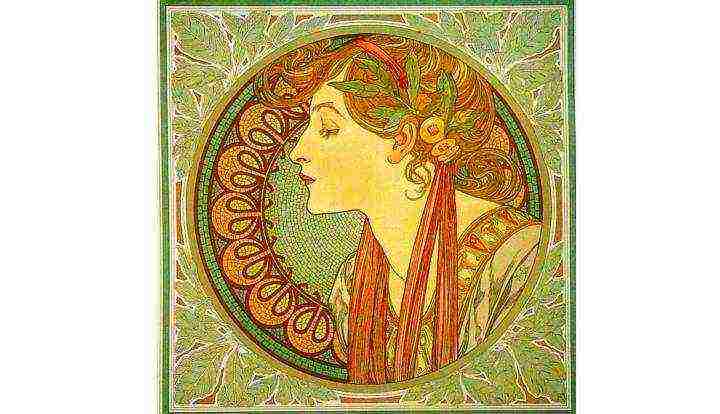
In addition, bay leaves were placed in mattresses so that the dreams that a person who slept on a mattress would dream of were prophetic. It was believed that the laurel could save from lightning.
It is also known that the Roman emperor Tiberius wore a wreath of laurel leaves and hid under the bed when thunder rolled.
Laurel noble - subtropical tree (shrub), from the Lavrov family.
Laurel branches and laurel wreaths are considered symbols of victory, peace, glory.
From the name of this plant came:
- Names: Lawrence, Laura, Lorenz, Laurus.
- Word "Laureate", which means "laurel crowned».
- Phraseologism "Reap laurels" those. reap the rewards of your success.
Laurel has long been considered a sacred tree, and laurel wreaths adorned the heads of those who were awarded the title of the winner.Now, bay leaves are used more as a spice.
Laurel noble - description
The birthplace of laurel is the Mediterranean. But on the territory of Modern Russia, it grows in the region of the Krasnodar Territory, in the southwest.
Appearance
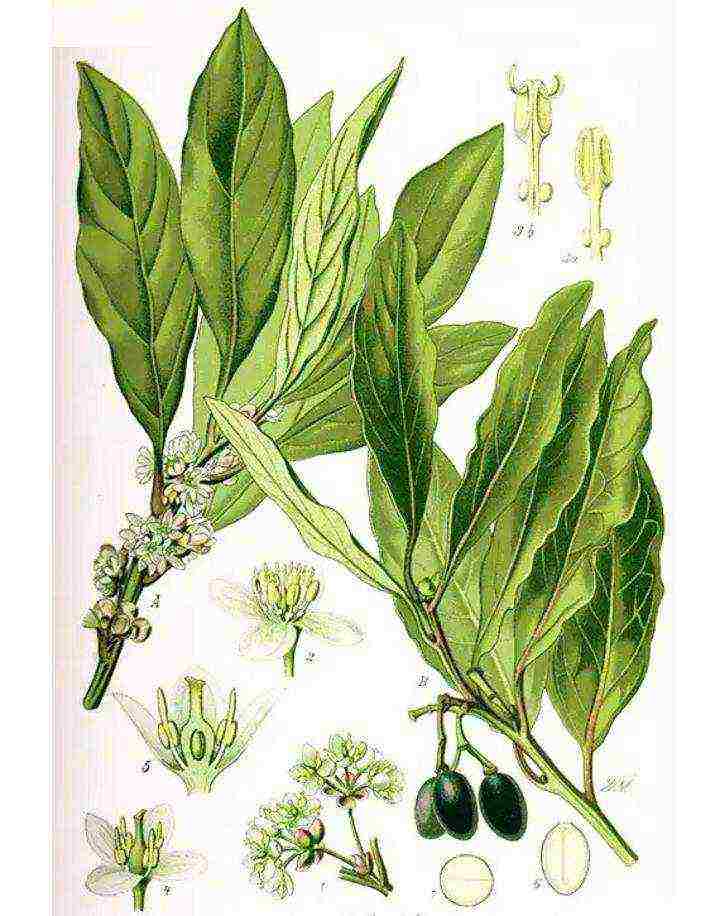 Wood. Laurel (noble) is a not very tall tree from the Lavrov family, up to 10 meters high, but sometimes it also happens in the form of a bush.
Wood. Laurel (noble) is a not very tall tree from the Lavrov family, up to 10 meters high, but sometimes it also happens in the form of a bush.
Sometimes (most often in the forest belt) you can find trees of this type up to 18 meters high.
Trunk usually 0.4 meters in diameter with dark gray bark.
Crown dense, has a pyramidal crown.
Leaves short (on petioles), shiny, oblong, slightly pointed. From above they are dark green, and to the bottom they are lighter, with venation, slightly wavy along the edges. They have a strong and tart characteristic odor.
Bloom.Laurel is a dioecious plant and has unisexual flowers. On some trees, staminate flowers are combined into inflorescences from six to twelve flowers, have a simple calyx-shaped perianth, consisting of four yellow-green or white leaves.

On the rest of the trees, flowers are only pistillate, even smaller, and are collected in leaf axils in several pieces.
Fruit laurel has bluish-black, juicy, fragrant drupes and everything is 2 cm long, usually elliptical or ovoid, with a large stone. The flowering period is March-April, and the fruits ripen in late October - early January.

Beneficial features
Bay leaves and their value cannot be overestimated, since they contain essential oils (almost 5%), cineole, valerian, acetic and caproic acids. The sheets contain geraniol, pinene, eugenol. The leaves and fruits contain tannins and bitterness.
- It is also used to treat chronic cholecystitis, gallstone disease.
- A decoction of bay leaf improves digestion, is a natural appetite stimulant, has a beneficial effect on the general condition of the body.
- Essential oils for the food industry are extracted from fruits, flowers and leaves.
- To some extent, they are also used in the field of soap making and perfumery.
Bay leaf and its uses
Bay leaves have a mild smell and bitter taste. In the form of a spice, it is used in dried form, powders and fruits, as well as briquettes, into which powder can sometimes be pressed. Its use is widespread in preservation and cooking.
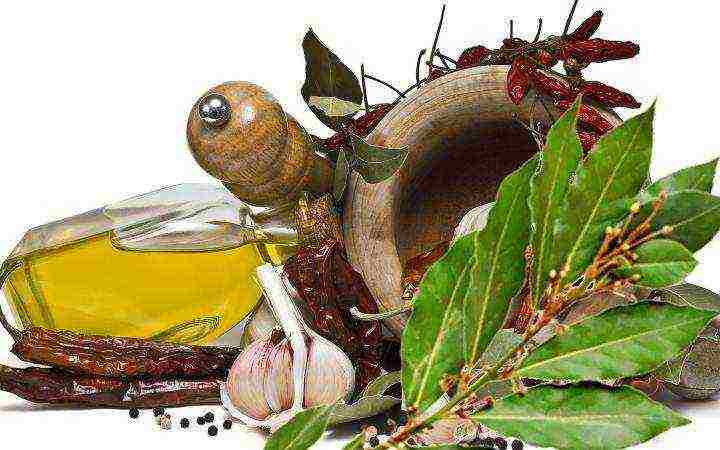
Bay leaf is called a spice by some people, as it is often used in cooking. It adds a noble flavor to dishes, especially gravies and sauces.
It is often added to first courses, for example, when preparing broth. It goes well with beans, beans, peas, carrots.
Unlike most spices, bay leaves can be added 5 minutes before cooking and at the start of cooking (the first 7-10 minutes). Usually one to four sheets are added.
Bay leaves are also irreplaceable in the preparation of jelly. It is also actively used in the manufacture of sausages and sausages, stew, sauces, preservation, and more. It is necessarily included in mixtures such as “Hmeli-suneli».
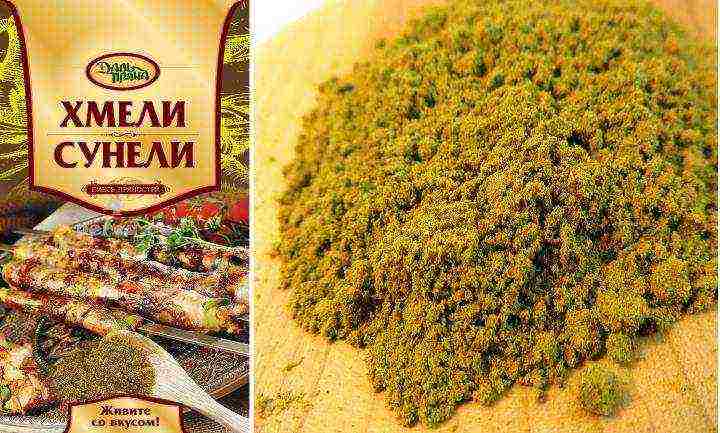
When preserved at home, bay leaves are also often used, especially for tomatoes, cucumbers, beets, beans, mushrooms, squash. In combination with other spices, it gives a unique aroma and pleasant taste.
In the West, there is still a tradition of adding bay leaves to certain types of preserves for canning and to certain sweet dishes, desserts and drinks.
Bay leaf - we grow at home
Laurel noble: cultivation
The laurel noble feels most comfortable in illuminated areas, but it can also tolerate darkening perfectly.
It can withstand short-term temperature drops up to 12 degrees below zero. It tolerates droughts well, not being picky about soils of different types.The growth and development of laurel is perfectly affected by fertilization with mineral and organic fertilizers. In one place, the laurel grows for 60 years.
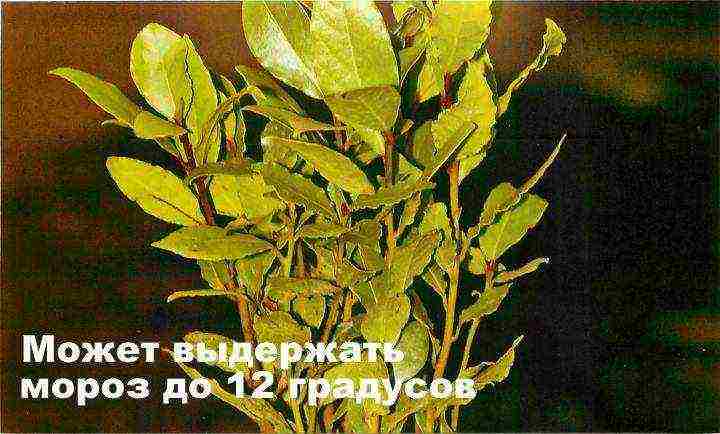
On industrial sites (plantations), laurel is grown in the subtropical regions, where the sum of effective temperatures per year is equal to 3000 degrees Celsius, and the temperature minimum does not fall below 12 degrees.
Before sowing, the soil is plowed to a depth of half a meter. Then organic and mineral fertilizers are applied, and then the site is harrowed and cultivated a couple of times. Planting is carried out in early spring or autumn.
The spaces between the rows are 1–2 meters, the spaces between the plants are 1.5 meters.
In such areas, laurel care is carried out through weeding, watering, cultivation and the fight against harmful insects.
But laurel can also be grown at home.
From November to February, the leaves are harvested from those trees that have reached the age of three and four years.
- The branches are cut with leaves and dried for 7-10 days.
- Then the leaves are removed, sorted and laid out in bags, which must be stored in dry rooms.
- To obtain essential oil, the leaves are used fresh - they are processed to produce oil.
Laurel breeding methods
Laurel reproduces well in three ways:
- cuttings,
- seeds and
- taps.
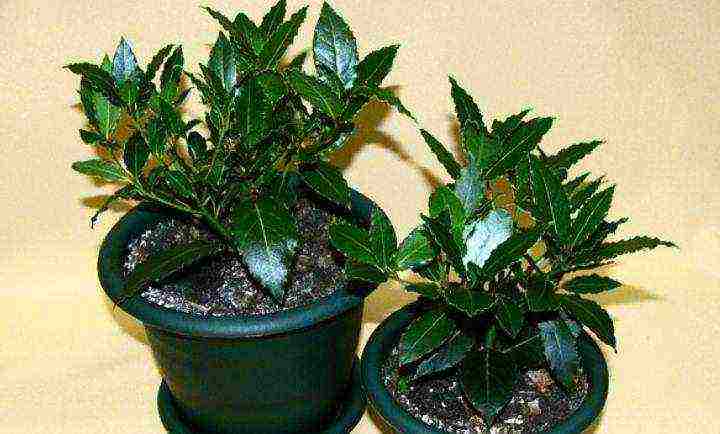
Planting material is grown from seeds in special nurseries, or seeds are sown in the ground. Seeds harvested from certain mother trees lose their freshness very quickly, therefore, after harvesting, they are immediately sown to a depth of four to five centimeters. After the emergence of seedlings, the borings are transplanted.
Cuttings
The most common method is propagation by semi-lignified cuttings.
In the spring, from about March to April, laurel cuttings are carried out, but sometimes it is also carried out in the summer (from June to July). In order to prepare cuttings, annual shoots of the plant are used, since they are already ripe, but not lignified.
Cuttings that were taken from the lower or middle part of the shoots of the bush are cut under the third node. The lower leaf is removed, and the upper ones are cut off, but only in half.
In the role of a substrate, so that the cuttings take root better, it is used coarse sand.

You can make yourself a mixture of sand and moss (sod land with sand):
- the drainage layer is poured into the pot,
- and then a layer of sod land (4 cm),
- and a little sand on top,
- and the cuttings are planted 1.5 cm deep.
For better rooting, the sprouts need to be ventilated and sprayed every day. At a temperature of sixteen to twenty degrees, rooting will take a month.
Growing laurel from seeds
Laurel seeds are large, in the shape of an oval and are up to two centimeters in length, with a thin shell that prevents the seeds from drying out and their premature germination.

Laurel seeds do not like drying and can germinate only in the first 3-5 months (and even then, only with proper storage). Before sowing, the seeds must be freed from the shell and sown in separate pots, or simply in a permanent place.
Seeds usually sprout from April to August. It also happens that sometimes the seeds can germinate in January, but in severe frosts, the seedlings are likely to die.
It will be best to keep plants in a room at a temperature of 10 degrees Celsius, and in the spring it is advisable to take the plant outside.
In the first year, feeding the seedlings is not necessary, but from the second year, mineral fertilizers in small doses can be used as feeding. Laurel will tolerate any soil except waterlogged.
If you grow laurel in your home, you will get a beautiful evergreen plant that will delight the eye every day.
TOP proven suburban shops in the Russian Federation - Choose, buy!
- - "Garden and Vegetable Garden" - Gardens of Russia is an online store of seeds and seedlings.
- - "Becker" is a popular store of seedlings, seeds, bulbs, delivery all over Russia!

Bay trees are cultivated in subtropical latitudes, and they grow there with pleasure. In Russia, laurels can be found in nature in the southwest of the Krasnodar Territory. However, like many other thermophilic plants, laurel can be grown at home. You just need to carefully consider the needs of this Mediterranean miracle and take care of it in the same way we take care of fish, parrots and other pets. Bay trees are cultivated in subtropical latitudes, and they grow there with pleasure.
 Bay leaf growing at home In Russia, laurels can be found in nature in the southwest of the Krasnodar Territory. However, like many other thermophilic plants, laurel can be grown at home. You just need to carefully consider the needs of this Mediterranean miracle and take care of it in the same way we take care of fish, parrots and other pets.
Bay leaf growing at home In Russia, laurels can be found in nature in the southwest of the Krasnodar Territory. However, like many other thermophilic plants, laurel can be grown at home. You just need to carefully consider the needs of this Mediterranean miracle and take care of it in the same way we take care of fish, parrots and other pets.
Laurel - houseplant
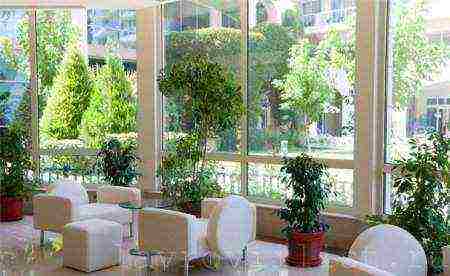 Laurel houseplant Fresh laurel leaves have a calm pleasant green color that will enliven any interior. Fragrant leaves will freshen and purify the air in the house, thanks to their ability to release phytoncides, which inhibit the development of bacteria and fungi.
Laurel houseplant Fresh laurel leaves have a calm pleasant green color that will enliven any interior. Fragrant leaves will freshen and purify the air in the house, thanks to their ability to release phytoncides, which inhibit the development of bacteria and fungi.
Laurel is a rather unpretentious plant. It is not as picky about growing conditions as lemon, for example. And if you plant a bay leaf at home, it will thrive even in the northern part of the house in less light conditions. But still, with sufficient illumination, the plant will turn out to be much lush and thicker.
The full-fledged bay leaves used in cooking will appear on your personal bay tree in just two years. It is at this age that the leaves acquire a rich aroma. In indoor conditions, laurel grows up to two meters, and with especially good care, even higher. So you can generously share your own bay leaf harvest with your friends.
For laurel, propagation by seeds, layering, cuttings and seedlings is acceptable.
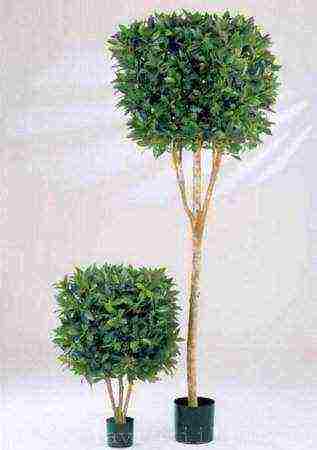 Laurel noble
Laurel noble
Growing laurel from seeds
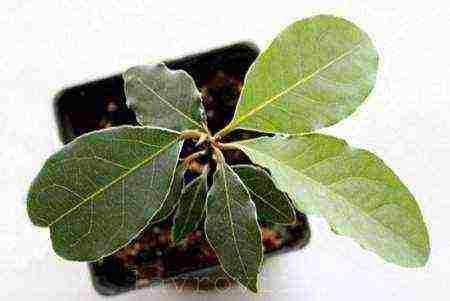 Cultivation of laurel from seeds The method of growing laurel with seeds is the most reliable, since the development of young plants from the very beginning occurs in the same conditions, and therefore they are not subjected to special stresses.
Cultivation of laurel from seeds The method of growing laurel with seeds is the most reliable, since the development of young plants from the very beginning occurs in the same conditions, and therefore they are not subjected to special stresses.
Laurel seeds can be found in flower shops or ordered online. Great luck and almost one hundred percent guarantee - freshly harvested seeds. But in any case, before sowing, you need to store the seeds in the refrigerator. This is the key to their best germination. In addition, laurel seeds have a thick skin, and in order to facilitate the emergence of a sprout, the seeds are soaked for several days. To accelerate germination and stimulate growth, it can be soaked in a special activating solution. For example, the growth drug "Epin" has shown itself to be excellent.
Any fertile soil is prepared for sowing seeds, but the top layer in a 2-3 cm thick container must be steamed or calcined sand. This is the best environment for the development of laurel seeds.
Seed peas are planted to a depth of 1 cm and covered with foil to retain moisture in the soil. Seeds germinate for a long time, up to several months. If you have patience and treat this process with love, they will surely hatch.
The optimal period for sowing seeds is during the winter months (January, February). Then, even if the seeds are late and lie in the ground for six whole months before germination, they will begin to develop in a favorable period both in temperature and in light.
And when this happens, they remove the film from the greenhouse and wait for the formation of the first leaves. Small laurels with two leaves can already be transplanted into a separate pot.
The site has detailed instructions for growing laurel from seeds.
How to propagate bay leaves at home
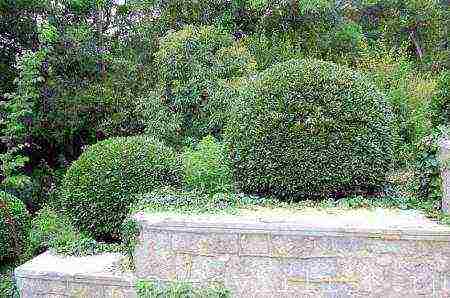 How to propagate bay leaves at home
How to propagate bay leaves at home
Growing laurel from cuttings
 Growing laurel from cuttings Growing a plant from cuttings is a more laborious process than sowing seeds. Laurel cuttings are harvested from an adult plant in the spring, when the trees wake up after winter, or in the first half of summer. Very successful cuttings are obtained from annual shoots that have not had time to lignify. The branches are cut into 6-8cm pieces.
Growing laurel from cuttings Growing a plant from cuttings is a more laborious process than sowing seeds. Laurel cuttings are harvested from an adult plant in the spring, when the trees wake up after winter, or in the first half of summer. Very successful cuttings are obtained from annual shoots that have not had time to lignify. The branches are cut into 6-8cm pieces.
Each cutting should have three internodes, that is, three free areas between the places of attachment of the leaves. For grafting, it is better to use the lower or middle part of the branch. Each stalk should have an oblique cut below. Then the first leaves must be removed, and the top ones must be cut off, leaving half a leaf - in order to minimize moisture evaporation. 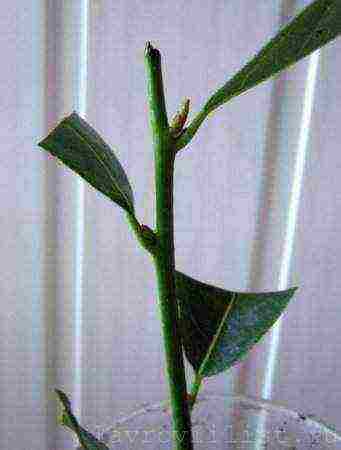 Pruning bay leaves
Pruning bay leaves
Any soil is suitable for bay leaves, but for planting cuttings it is better to prepare a nutritious substrate of your choice:
a mixture of 1 part of leafy soil with 1 part of marsh moss;
a mixture of 1 part of sod land and 1 part of sand;
a mixture of 1 part sand and 1 part moss;
just coarse sand.
Bay plants are very tolerant of any soil. The only thing they cannot stand is excessive waterlogging. So, almost the main condition for the successful cultivation of laurel is good drainage.
It is advisable to steam the prepared soil in order to avoid damage to the cuttings by pathogenic bacteria. The sand can be ignited. Any suitable drainage is placed at the bottom of the container.
For better rooting, you can use special stimulants that promote root formation. Powder Kornevin is suitable for this purpose. The lower part of the cutting should be dipped in the growth preparation powder. And you can keep the bases of the cuttings (immersed by 2-3 cm) for a day in a special solution of heteroauxin. The roots from such a procedure will turn out to be well branched and strong. Some gardeners use phytohormones for better rooting, and also organize bottom heating for cuttings.
The cuttings are buried 1.5 cm in the ground.They need to be provided with watering and a temperature of at least 22 degrees. To maintain the temperature regime, the cuttings are covered with a suitable transparent material: film, glass or a jar. Every day, the shelter needs to be briefly removed or opened for ventilation. It is useful not only to water the cuttings, but also to spray them with water. The first three weeks - this should be done 4-5 times a day. Then the number of sprays is gradually reduced.
It will take about one month for rooting. Once the plants have taken root, you can transplant them into another container. For the substrate, garden or sod land, leaf land and sand are taken. You can add a little peat and lime (5-10g).
Growing seedlings from horizontal layers
 Growing seedlings from horizontal layers A laurel tree can be grown from a layer as is done with grapes. Take one of the lower branches, put it in a groove, pin it to the ground and sprinkle it with soil. In the place where the branch will cover the ground, you need to make an incision or at least a scratch on the bark.
Growing seedlings from horizontal layers A laurel tree can be grown from a layer as is done with grapes. Take one of the lower branches, put it in a groove, pin it to the ground and sprinkle it with soil. In the place where the branch will cover the ground, you need to make an incision or at least a scratch on the bark.
A prerequisite for successful germination is a sufficient amount of moisture.
As soon as a green sprout appears from under the ground, you can dig out a layer and cut it off from the main branch. Then plant the young plant in a separate container.
Growing laurel seedlings
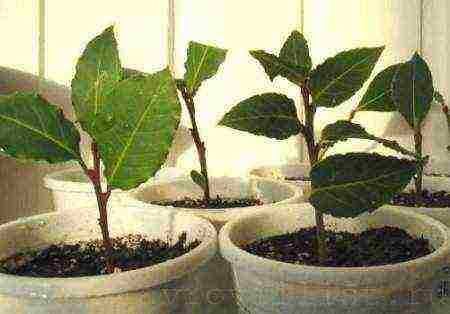 Growing laurel seedlings Buying ready-made laurel seedlings is no longer a problem. And the price for them is very democratic.
Growing laurel seedlings Buying ready-made laurel seedlings is no longer a problem. And the price for them is very democratic.
As soon as pets appear in the house, they need to be placed where there is diffused lighting or partial shade. At least they don't need direct sunlight for the acclimatization period.
It should also be the coolest place in the house, since laurel is not one of those who love high temperatures.A pleasant thermal regime for laurel is 15-20 degrees in summer and 10-12 in winter.
Laurel loves humid air. Therefore, it can be humidified in different ways: by spraying, containers with water next to the pot, shower.
When the time comes to pinch and prune bay trees, move them to a lighter spot for better branching.
Recommendations for proper cultivation
 Recommendations for the correct cultivation of laurel Laurel responds well to organic fertilizers. This could be, for example, pigeon droppings. It is diluted with water, preferably settled. For one part of the litter, take 20 parts of water. Laurel will also accept mineral fertilizers well. You can feed him once every three weeks.
Recommendations for the correct cultivation of laurel Laurel responds well to organic fertilizers. This could be, for example, pigeon droppings. It is diluted with water, preferably settled. For one part of the litter, take 20 parts of water. Laurel will also accept mineral fertilizers well. You can feed him once every three weeks.
 Recommendations for the correct cultivation of bay leaves Laurel is very fond of water, so at least once a month he needs to arrange a warm refreshing shower. You also need to water the plant with warm, settled water. In the cold season, this is done once every five days, and in the warm season, more often - once every three days.
Recommendations for the correct cultivation of bay leaves Laurel is very fond of water, so at least once a month he needs to arrange a warm refreshing shower. You also need to water the plant with warm, settled water. In the cold season, this is done once every five days, and in the warm season, more often - once every three days.
Bay trees need to be replanted periodically. At a young age, the transplant is carried out after two years, and older trees need to be disturbed less often - once every five years. After transplanting, laurel does not need to be fertilized for about six months. But fresh air will not interfere with it. As long as the temperatures allow, the laurel can be kept on the balcony or in the garden, and brought into the room before winter.


